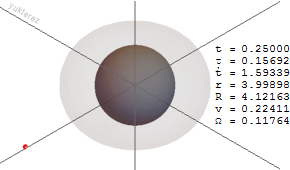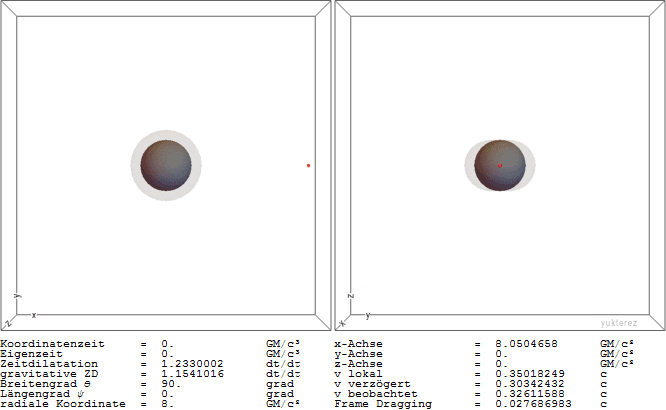What is more exciting than a black hole? A rotating black hole!
We know that a collapsed star can form a black hole, a region of spacetime from which nothing can escape from, not even light. The event horizon is the spherical surface that represents the point of no return. Once you’ve entered, you can’t exit.
If the collapsed star is rotating around an axis, then the black hole will be rotating too and it’ll have some amazing properties.
1) Non Planar Orbits
Newton’s theory of gravitation predicts that when something orbits around a much more massive body it follows a trajectory that always remains on the same plane (depending on the starting conditions, an ellipse, a parabola or a hyperbola).
In Einstein’s general relativity theory things are much more complex, and a massive rotating body creates a gravitational field that not only attracts objects toward its center but also drags small bodies in the direction of its rotation.
In the following animation you see a body approaching a rotating black hole. It starts going against the direction of the black hole’s rotation but soon the black hole drags the body into orbiting in its same direction.

As a consequence of this dragging effect, orbits around a rotating black hole in general are not planar, and for some initial conditions they can even densely fill a torus-like region around the black hole.

2) Energy Extraction
The rotating black hole is surrounded by a surface called an ergosphere. The ergosphere is a sort of ellipsoid and touches the event horizon at the poles of the black hole.

It can be shown that it is possible to throw a body into the ergosphere and split it into two, with one part falling inside the black hole and the other escaping outside the ergosphere with more kinetic energy than the body thrown in at the beginning.
This process tends to slow the black hole rotation and to thin the ergosphere. Finally, when the black hole ceases to rotate, the ergosphere overlaps the event horizon and energy can no longer be extracted.
Great! You can extract energy from a system that doesn’t let light escape!
Is anything more mind-blowing than this? Keep reading!
3) Time Travel
Another cool feature of rotating black holes is that inside the event horizon there are closed timelike curves. OK, but… what the hell does this mean? It means that if a brave astronaut were to go close enough to the black hole center he could return many times to the same spacetime point and meet himself.
This is great news for science fiction writers! But (here comes the bad news) it seems this kind of time travel is only theoretically possible for a black hole that has always existed. For real black holes formed from a collapsing star, time traveling could not be possible (science writers, don’t blame me).
That’s all folks!
If you liked this post, please share it and signup to receive the newsletter. Subscribers get the math and physics 2017 calendar for free!


